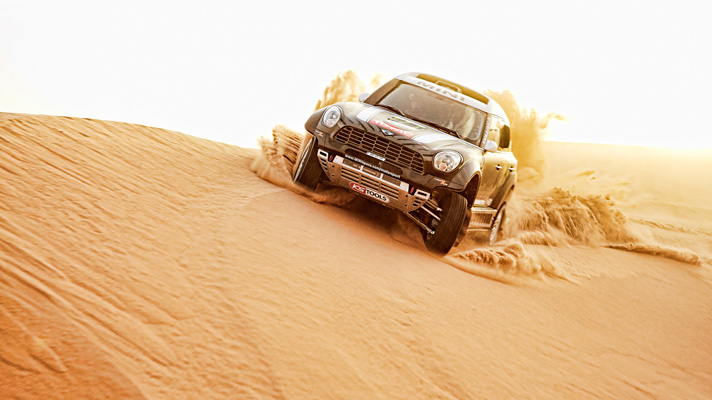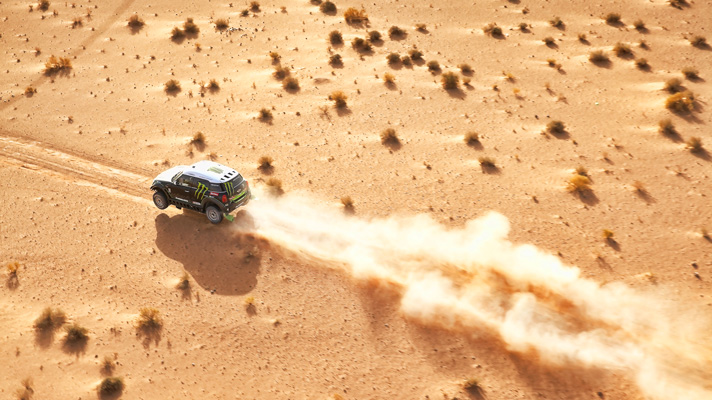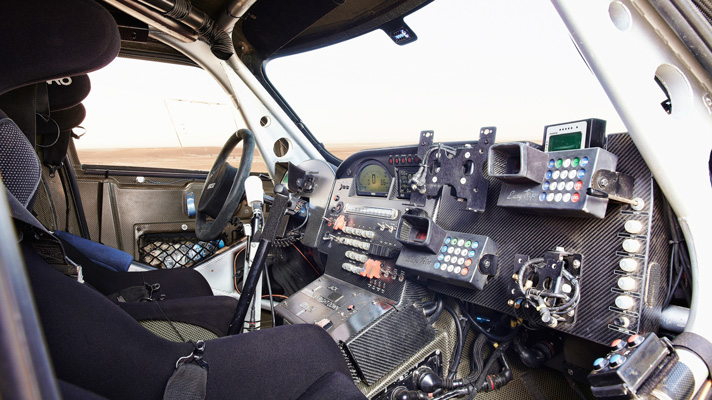
First drive: Mini All4 Dakar X-Raid
Ah, something that looks like a Mini, but probably isn't.
Bang on. In fact inside the only bit I can spot that seems to have had some previous Mini-related life is the throttle pedal. The bodywork itself? Well, that's made of carbon fibre and is precisely 1.75 per cent larger all round than the panels fitted to a standard Countryman.
Aren't you getting a bit ahead of yourself? What's it actually for?
Racing the Dakar Rally. The epic 15-day cross-country endurance rally starts in central Argentina on the 5th January and runs northwards into Bolivia, then swings south through Chile, covering a total of 9,374km. Well, the cars do, the trucks, quads and bikes do a few kilometres less. Either way, it's an immensely serious and hardcore event that makes up in spectacle what it's lost a little in adventure since its relocation from Africa.
The terrain looks pretty Saharan in the pictures.
For various reasons, not least geographical proximity, the mostly European teams that compete in the Dakar still do their testing in Morocco, so use the area south of the Atlas Mountains to do their pre-season checks and set-up. I went out to join the privateer X-Raid team that, with a bit of BMW backing, is entering this very Mini you see here in the Dakar.
OK, crack on, what's it like to drive?
Now I'm going to tell you to hold your horses while I point out that it's the car driven to victory for the past two years on the trot by a chap called Stephane Peterhansel. He's a genuine Dakar legend, having won the race eleven times in total, six on a motorbike, five in a car. There's probably never been a better rally raid driver.
And they let you drive his car?
Well, if it's tough enough for Dakar it should be able to cope with a couple of hours of TopGear cack-handedness, shouldn't it? Particularly since both the team and Peterhansel himself tell me the car is way tougher than the chap driving it. Stephane told me that it used to be that if you hit a big hole the front suspension would break, the wheel would be smashed, the damper would pop, but now it's just the driver that gets beaten up. Humans are the weakest link.
Tell me you didn't break it.
I didn't break it.
Good. Now tell me what it was like.
For starters it uses a 3.0-litre BMW diesel, pretty much the same as the one in the 530d, only largely unsilenced. This means it sounds more like a Challenger battle tank on the move, all shrill turbo whistle and guttural engine clatter. It has pretty much the same usable rev range and table top torque curve as a diesel road car, although there's no super-slick eight speed auto here to round off any rough edges. Instead drive goes to all four wheels through a six-speed sequential manual gearbox. It's quick enough. X-Raid won't reveal exact power figures, but will say the numbers quoted on their website (311bhp and 523lb ft) are broadly accurate. I reckon it's about 6.0secs-to-60mph quick. It would be much faster if it didn't have to run a slender 38mm air restrictor and was allowed to weigh less than 1925kg. Plus drivers. Plus fuel. All up weight (with 400 litres of fuel on board) must be close to 2.5 tonnes.
Wow. Why so much?
Well, quite rightly the race organisers want the cars to be tough, but also rather oddly the technical regulations don't favour 4wd cars such as the Mini, and instead seem to be more lenient to the 2wd petrol buggies. However, no matter how you judge it 311bhp is plenty enough to get you into trouble. What gets you out of trouble is an effortlessly accomplished suspension and chassis set-up. Now, at this stage I should admit that I had some pretty set ideas of how the Dakar Mini would drive before I climbed into it. I have never been more wrong about anything in my life.
How so?
Well, I assumed that a car set-up to race 5-600km long stages on impossibly savage terrain would have masses of suspension travel, would ooze and slosh around the place, suspension jack-hammering about, but body placid on top. I thought it would be the kind of car you just gently guided around, letting it choose it's own path. No.
Instead, it skittles and rattles and crashes and ricochets about, generally giving those on board a most terrifically tough time. It's little more than a torture chamber off-road, only finally smoothing out when it hits deep sand - about the only thing that actually slows it down. And the handling? Sharp, and amazingly tail happy. The handling is far more WRC than Baja buggy, it's adjustable and will get you into trouble if you lose concentration for a split-second.
Top Gear
Newsletter
Thank you for subscribing to our newsletter. Look out for your regular round-up of news, reviews and offers in your inbox.
Get all the latest news, reviews and exclusives, direct to your inbox.
Why is it set-up like that?
Once again, it's down to the regulations, this time those that restrict the Mini to a pitiful 250mm of suspension travel. And bear in mind that most of that travel is needed to take the big hits, when Peterhansel lands 2.5 tons of Mini from a couple of metres in the air at 100mph. Seriously. I saw him do that and my mind boggled slightly. Anyway, it's those impacts that use the far ends of the travel. The ‘workaday' stuff I was doing? Barely getting the suspension to start moving I shouldn't wonder. There are no active diffs or dampers either - everything's passive, although there are some very neat features like valves in the dampers that detect side loads during cornering and slide to keep the car level.
Did you ever get to grips with it?
Not properly. It requires an enormous amount of trust and experience to drive fast and the back axle is so lively that it seems to spend most of its time in the air, kicking about like a mule. It requires a surprisingly different technique and skill set to any other type of motorsport I've come across. Sure, it's a lot like rallying, but the terrain is way more brutal, and that brings you back round to the fact that you, the driver, are the weakest link in the chain. The battering is frankly inhuman. Neck, back, pelvis, collarbone, stomach, teeth: all ache and throb even after a relatively sedate punt around the desert. When I got back Peterhansel took me out for a drive. I very nearly told him to slow down. I have never in my life before told anyone to back off or slow down.
So you have respect for what he does?
Hugely. But it's not just about him. I'm still startled that it's possible to build a car as tough as this, to do what this one is capable of, the impacts it can tolerate. It's not just the engine noise that's tank-like...
NB: You can read a full feature on my drive in the Dakar Mini in the magazine this month, or if you want to see video footage, download the latest iPad app. I know I would say this, but the video that goes with it is pretty cool.









